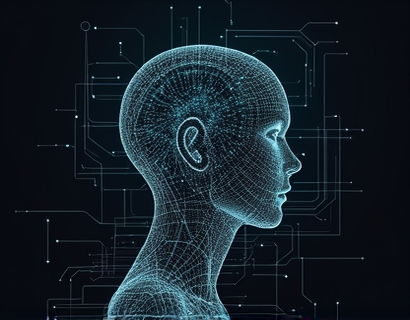Revolutionizing Business Analytics with AI and Blockchain: A Secure and Transparent Approach to User Tracking
The integration of Artificial Intelligence (AI) and Blockchain technology is transforming the landscape of business analytics, particularly in the realm of user tracking and behavior analysis. This fusion offers unparalleled insights into user behavior, enabling businesses to enhance engagement and make strategic decisions with confidence. The following discussion delves into how this powerful combination ensures a secure and transparent analytics experience, providing businesses with a competitive edge in today's data-driven market.
The Role of AI in Business Analytics
Artificial Intelligence has become an indispensable tool for businesses aiming to extract meaningful insights from vast amounts of data. AI algorithms can process and analyze complex datasets at speeds and scales unattainable by human analysts. In the context of user tracking, AI can identify patterns, predict behaviors, and segment audiences with high precision. This capability is crucial for businesses looking to personalize user experiences, optimize content delivery, and improve overall engagement.
Machine learning, a subset of AI, plays a pivotal role in enhancing the accuracy of user behavior predictions. By continuously learning from new data, AI models can adapt and refine their predictions over time. This dynamic learning process ensures that businesses stay ahead of user trends and can respond swiftly to changes in consumer behavior. For instance, AI can analyze clickstream data to predict which products a user is likely to purchase next, allowing for targeted recommendations that boost conversion rates.
Blockchain: Ensuring Security and Transparency
While AI offers powerful analytical capabilities, the integration of Blockchain technology addresses the critical concerns of data security and transparency. Blockchain's decentralized and immutable nature ensures that user data is stored securely and cannot be altered without consensus from the network. This feature is particularly important in user tracking, where data privacy and integrity are paramount.
Each transaction in a Blockchain network is recorded in a block, which is linked to the previous block through cryptographic hashes. This chain of blocks creates an unbreakable record of all transactions, making it nearly impossible to tamper with the data. For businesses, this means that user tracking data can be trusted, and users can have confidence that their information is handled responsibly.
Combining AI and Blockchain for Enhanced Analytics
The synergy between AI and Blockchain creates a robust framework for business analytics. AI algorithms can process and analyze data stored on a Blockchain, leveraging the security and transparency of the technology to provide accurate and reliable insights. This combination allows businesses to gain deep insights into user behavior without compromising on data integrity or user privacy.
For example, a retail company can use AI to analyze transaction data stored on a Blockchain to identify purchasing patterns, preferences, and trends. The AI can then provide actionable recommendations for inventory management, marketing strategies, and customer engagement initiatives. Since the data is immutable and transparent, the company can share these insights with partners and stakeholders with confidence, fostering trust and collaboration.
Benefits of AI and Blockchain in User Tracking
The integration of AI and Blockchain in user tracking offers numerous benefits that traditional methods cannot match. Here are some key advantages:
- Enhanced Security: Blockchain's decentralized and encrypted nature protects user data from breaches and unauthorized access.
- Transparency: All transactions are recorded and verifiable, ensuring that data handling is transparent and accountable.
- Accuracy: AI algorithms can process large datasets with high precision, leading to more accurate user behavior predictions.
- Personalization: AI-driven insights enable businesses to create highly personalized user experiences, increasing engagement and customer satisfaction.
- Compliance: The immutable nature of Blockchain helps businesses comply with data protection regulations, such as GDPR, by providing a clear audit trail.
Case Studies and Real-World Applications
Several businesses have successfully implemented AI and Blockchain solutions for user tracking and analytics. One notable example is a leading e-commerce platform that integrated these technologies to enhance its recommendation engine. By analyzing transaction data stored on a Blockchain, the AI system could provide more accurate and personalized product suggestions. This led to a significant increase in sales and customer loyalty.
Another case involves a financial services company that used AI and Blockchain to monitor and analyze user interactions with its digital banking platform. The combination of AI and Blockchain allowed the company to detect fraudulent activities in real-time, reducing losses and enhancing user trust. The transparent and secure data handling also facilitated compliance with regulatory requirements, streamlining the audit process.
Challenges and Considerations
While the benefits are substantial, there are challenges and considerations to keep in mind when implementing AI and Blockchain for user tracking:
- Technical Complexity: Integrating AI and Blockchain requires specialized expertise and can be technically challenging to implement.
- Scalability: Ensuring that the solution can handle large volumes of data and scale with business growth is crucial.
- User Education: Educating users about the benefits and functionality of these technologies is essential for adoption and trust.
- Regulatory Environment: Navigating the regulatory landscape, especially regarding data privacy and security, is ongoing and requires vigilance.
Future Trends and Innovations
The convergence of AI and Blockchain is an evolving field with exciting future prospects. Here are some trends and innovations to watch:
1. Decentralized Analytics Platforms: The development of decentralized analytics platforms that leverage Blockchain to manage data sharing and access control, empowering users to have more control over their data.
2. Quantum AI: The potential integration of quantum computing with AI to further enhance processing power and analytical capabilities, enabling more sophisticated user behavior analysis.
3. Interoperability Standards: Efforts to create standards that ensure different Blockchain networks and AI systems can work together seamlessly, fostering a more connected and efficient ecosystem.
4. Enhanced Privacy Features: Continuous improvements in privacy-preserving technologies, such as zero-knowledge proofs, to further protect user data while maintaining transparency.
Conclusion
The fusion of AI and Blockchain is revolutionizing business analytics by providing secure, transparent, and accurate user tracking solutions. This powerful combination enables businesses to gain deep insights into user behavior, enhance engagement, and make data-driven decisions with confidence. As the technologies continue to evolve, the potential for innovation and growth in the realm of business analytics is vast. Embracing these advancements can give businesses a significant competitive advantage in the digital age.




































